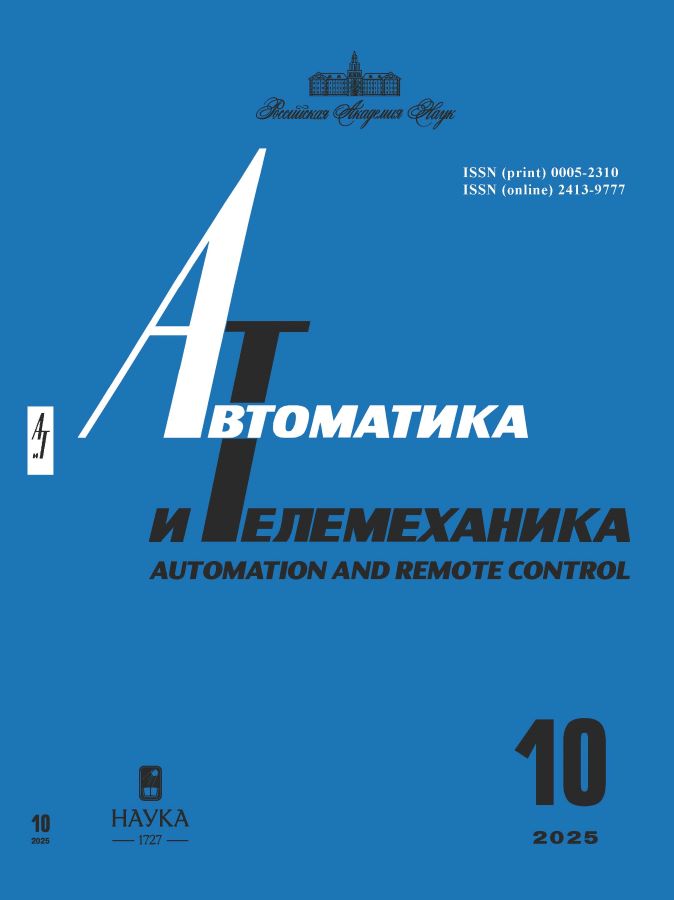Statistical Complexity as a Criterion for the Useful Signal Detection Problem
- Authors: Galyaev A.A.1, Lysenko P.V.1, Berlin L.M.1
-
Affiliations:
- Trapeznikov Institute of Control Sciences, Russian Academy of Sciences
- Issue: No 7 (2023)
- Pages: 121-145
- Section: Optimization, system analysis, and operations research
- URL: https://ruspoj.com/0005-2310/article/view/646756
- DOI: https://doi.org/10.31857/S0005231023070073
- EDN: https://elibrary.ru/FDVSTA
- ID: 646756
Cite item
Abstract
Three variants of the statistical complexity function, which is used as a criterion in the problem of detection of a useful signal in the signal-noise mixture, are considered. The probability distributions maximizing the considered variants of statistical complexity are obtained analytically and conclusions about the efficiency of using one or another variant for detection problem are made. The comparison of considered information characteristics is shown and analytical results are illustrated on an example of synthesized signals. A method is proposed for selecting the threshold of the information criterion, which can be used in decision rule for useful signal detection in the signal-noise mixture. The choice of the threshold depends a priori on the analytically obtained maximum values. As a result, the complexity based on the total variation demonstrates the best ability of useful signal detection.
About the authors
A. A. Galyaev
Trapeznikov Institute of Control Sciences, Russian Academy of Sciences
Email: galaev@ipu.ru
Moscow, Russia
P. V. Lysenko
Trapeznikov Institute of Control Sciences, Russian Academy of Sciences
Email: pavellysen@ipu.ru
Moscow, Russia
L. M. Berlin
Trapeznikov Institute of Control Sciences, Russian Academy of Sciences
Author for correspondence.
Email: berlin.lm@phystech.edu
Moscow, Russia
References
- Shannon C.E. A Mathematical Theory of Communication // Bell Syst. Tech. J. 1948. V. 27. P. 379-423.
- Gray R.M. Entropy and Information Theory. New York: Springer, 2011. https://doi.org/10.1007/978-1-4419-7970-4
- Holub A., Perona P., Burl M.C. Entropy-based Active Learning for Object Recognition // Computer Society Conference on Computer Vision and Pattern Recognition Workshops (CVPRW), IEEE. 2008. P. 1-8. https://doi.org/10.1109/CVPRW.2008.4563068
- Osisanwo F.Y., Akinsola J.E.T., Awodele O. et al. Supervised Machine Learning Algorithms: Classification and Comparison // Int. J. Comput. Trends Technol. (IJCTT). 2017. V. 48. No. 3. P. 128-138. https://doi.org/10.14445/22312803/IJCTT-V48P126
- Shen J., Hung J., Lee L. Robust Entropy-based Endpoint Detection for Speech Recognition in Noisy Environments // Proc. 5th International Conference on Spoken Language Processing (ICSLP). 1998. https://doi.org/10.21437/icslp.1998-527
- Ribeiro M., Henriques T., Castro L., Souto A., Antunes L., Costa-Santos C., Teixeira A. The Entropy Universe // Entropy. 2021. V. 222. No. 2. art. 222. https://doi.org/10.3390/e23020222
- Ramirez J., Segura J.C., Benitez C. et al. A New Kullback-Leibler VAD for Speech Recognition in Noise // IEEE Signal Proc. Lett. 2004. V. 11. No. 2. P. 266-269. https://doi.org/10.1109/LSP.2003.821762
- Horie T., Burioka N., Amisaki T., Shimizu E. Sample Entropy in Electrocardiogram During Atrial Fibrillation // Yonago Acta Medica. 2018. V. 61. No. 1. P. 49-57. https://doi.org/10.33160/yam.2018.03.007
- Lamberti P.W., Martin M.T., Plastino A., Rosso O.A.Intensive Entropic NonTriviality Measure // Phys. A: Stat. Mech. Appl. 2004. V. 334. No. 1. P. 119-131. https://doi.org/10.1016/j.physa.2003.11.005
- Lopez-Ruiz R. Shannon Information, LMC Complexity and Renyi Entropies: A Straightforward Approach // Biophys. Chem. 2005. V. 115. No. 3. P. 215-218. https://doi.org/10.1016/j.bpc.2004.12.035
- Zunino L., Soriano M.C., Rosso O.A. Distinguishing Chaotic and Stochastic Dynamics from Time Series by Using a Multiscale Symbolic Approach // Phys. Rev. E. Stat. Nonlin. Soft. Matter Phys. 2012. V. 86. No. 4. P. 1-5. https://doi.org/10.1103/PhysRevE.86.046210
- Ronald L.A., Duncan W.M. Signal Analysis: Time, Frequency, Scale, and Structure. N.J.: IEEE Press, 2004.
- Ширяев А.Н. Вероятностно-статистические методы в теории принятия решений. М.: МЦНМО: НМУ, 2020.
- Kishan G.M., Chilukuri K.M., HuaMing Huang. Anomaly Detection Principles and Algorithms. Cham: Springer. 2017. https://doi.org/10.1007/978-3-319-67526-8
- Berlin L.M., Galyaev A.A., Lysenko P.V. Comparison of Information Criteria for Detection of Useful Signals in Noisy Environments // Sensors. 2023. V. 23. No. 4. art. 2133. https://doi.org/10.3390/s23042133
- Johnson P., Moriarty J., Peskir G. Detecting Changes in Real-Time Data: A User's Guide to Optimal Detection // Philos. Trans. Royal Soc. A. 2017. V. 375. P. 16. art. 2100. https://doi.org/10.1098/rsta.2016.0298
- Li Z., Li Y., Zhang K.A. Feature Extraction Method of Ship-Radiated Noise Based on Fluctuation-Based Dispersion Entropy and Intrinsic Time-Scale Decomposition // Entropy. 2019. V. 21. No. 7. art. 693. https://doi.org/10.3390/e21070693
- Sason I. On f-Divergences: Integral Representations, Local Behavior, and Inequalities // Entropy. 2018. V. 20. No. 5. art. 383. https://doi.org/10.3390/e20050383
Supplementary files











